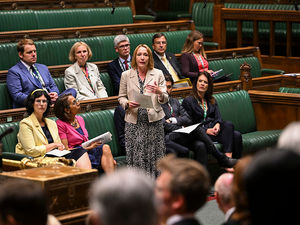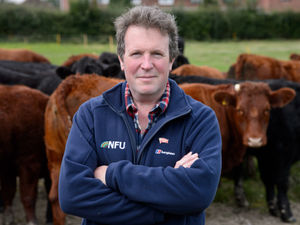Grass is greener for dairy farm
Any four-year-old child could tell you that cows eat grass. And according to one Shropshire farm, the solution to dairy farming really is that simple.
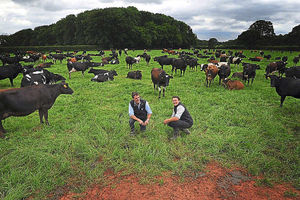
With milk prices about as predictable as the weather, farmers have searched far and wide for a sustainable method of milk production.
Some have employed intensive methods, housing large numbers of cows indoors and giving them specialised feed rather than fields to graze during the year.
But Sansaw Estate farm, in Hadnall, near Shrewsbury, has employed a different technique which seems to rely entirely on growing grass.
James Thompson, managing director of Sansaw Estate, said the approach replicates that used heavily in New Zealand.
He said: "Cows eat grass. It's as simple as that, they can get all they need from grass and it's a lot cheaper.
"Instead of feeding them a mixture of grass, grains, minerals and whatever else goes into the feed, we employ this method.
"We can't be reliant on our milk price; whilst milk prices go up and down, feed prices rise and fall too so it can be hard to pay for feed when milk prices are low.
"But we can rely on the constant cost of grass; as long as we can grow enough to feed the cows, we can offset the fall of milk prices."
Mr Thompson describes the project as a predominantly grass farming business, rather than your typical dairy farm.

With any success or failure relying on growing enough of the stuff, it's fair to say weather plays a crucial role.
Mr Thompson said: "We're avid forecast watchers – I have about four apps on my phone telling me what the weather will be!
"It wouldn't work in a lot of countries though, we're lucky in England to have quite a temperate climate.
"In the winter months, we have a deficit of grass to feed the amount of cows we have, and in the summer we have surplus grass.
"We have to make sure we keep the surplus as a stockpile for the winter months to feed the cows when there isn't enough, so we still produce silage."
The farm holds 1,170 cows on 1,200 acres of land, and employs six full-time staff, with an extra two during busy periods.
While it may sound simple and easy, the system is very regimented to ensure maximum efficiency all year round.
The farm plan breeding and calving for specific points in the year so that there are cows with a large appetite during periods of surplus grass.
As a business, farmers have to be ruthless with the cows and cull those that are no longer useful to the production.
Mr Thompson explained: "Any cow that is not in calf or one that has mastitis and cannot produce milk, will be culled as you have to take out any unproductive cows.
"First of all it's a business, but it's also to be fair to the cows."
To keep a detailed check on the health of the cows, they are monitored twice a day during milking, and again in the field.
During the year, milk samples are also taken to detect bacteria levels in the animals which can show which cows may be susceptible to the inflammatory udder disease masititis.
But alongside the positives of low production cost, it appears there are benefits for the consumer. While intensive farming can produce more milk, many argue that this style can give a higher quality of milk.
"Our cows are very efficient converters of grass into milk," said Mr Thompson.
"The breed of cow we look for gives a high butter high protein content and this can be turned into produce of value.
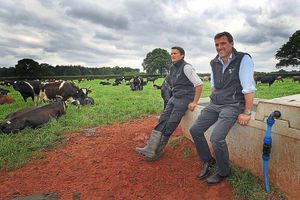
"If you have got a low fat and protein content, it is effectively white water, which is fine for supermarkets stocking milk but not for quality butter and cheese."
Having spent years researching methods of farming, the estate chose this one because of its suitability for the business, and has employed it since the opening of its £3 million unit in 2012.
But it's not for everyone. According to Mr Thompson, the New Zealand method works well in its home country because of the style of market and huge amounts of exports, but it's not the most cost effective route for all farmers.
Mr Thompson said: "It's a system that works for us because of our land mass but for farms without the grass it's not sustainable.
"It's a very different market place than in New Zealand where about 95 per cent of produce is exported."
Nevertheless, thanks to its massive land space, Sansaw can continue to feed their cows with acres of grass in the traditional way.
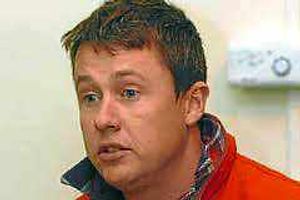
Stark contrast as mega dairy work to start:
In stark contrast to the system adopted by the Sansaw Estate, farmer Fraser Jones is preparing to start work on a 1,000-cow indoor mega dairy.
Mr Jones, 31, of Lower Leighton Farm in Leighton, near Welshpool, said work will begin on the dairy in the coming weeks after finally being given planning permission last week.
Mr Jones says the dairy – which he says will provide up to nine jobs – will allow him to keep his business in Powys.
But the plans caused outrage in the area with villagers setting up the Campaign Against Leighton Farm expansion (CALFe) group, taking Mr Jones first to a public inquiry and then supporting a high court judicial review.
CALFe said the dairy would be cruel to the cows and be detrimental to the local area, especially as it will be based near a primary school.
The Welsh Assembly gave Mr Jones planning permission following the public inquiry on the basis that it would provide a much needed boost to the local economy.
But the World Society for the Protection of Animals (WSPA) was granted a high court judicial review which was held in Welshpool this month.
Judge Gary Hickinbottom ruled against WSPA, which was claiming the negative impact on the region's landscape would outweigh the economic benefits.
Following the verdict, Mr Jones said: "I am obviously delighted that I can now get on and expand my business and create good jobs for local people.
"I am relieved but furious though. It is six years since I first put the plans on the table and I have had no help from Powys County Council and this has dragged on long enough.
"I am a young businessman who is trying to make something of myself in my home county and all I get is trouble and no assistance.
"I want to create jobs for local people to keep them in the area. We are always hearing about how Powys youngsters have to move away to Essex or London to get jobs and here I am trying to reverse that and they are not helping."
Mr Jones said the application process had cost him in the region of £200,000, with WSPA ordered to pay his £6,000 costs for the appeal. He said work will begin on the £3.5 million dairy "within weeks" and will take up to five years to complete.
But the WSPA maintains that the dairy is not safe for the cows.



